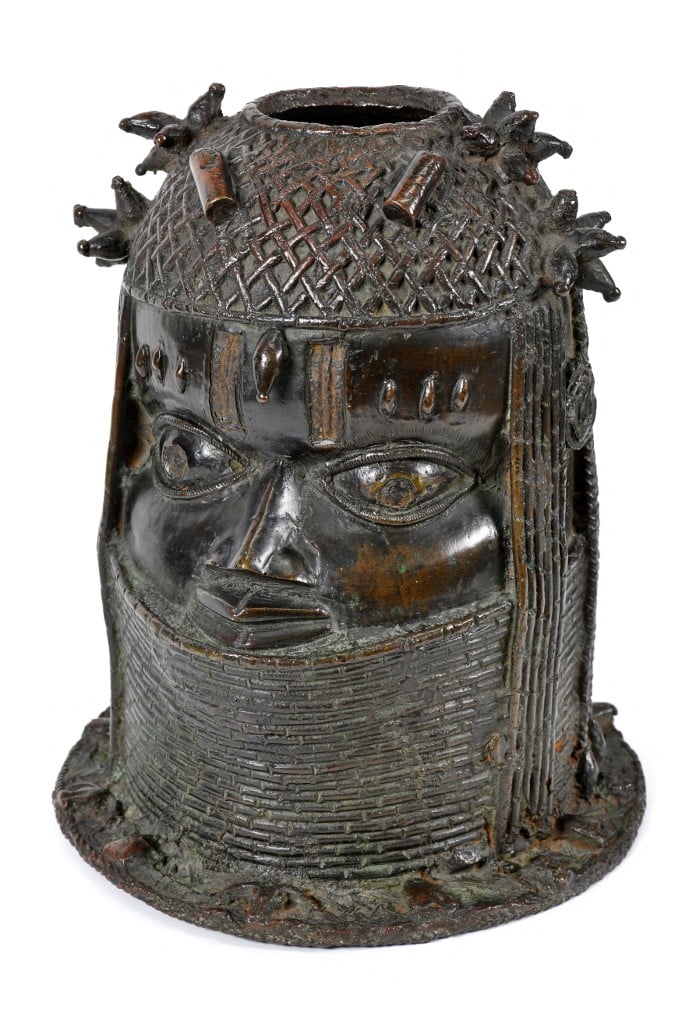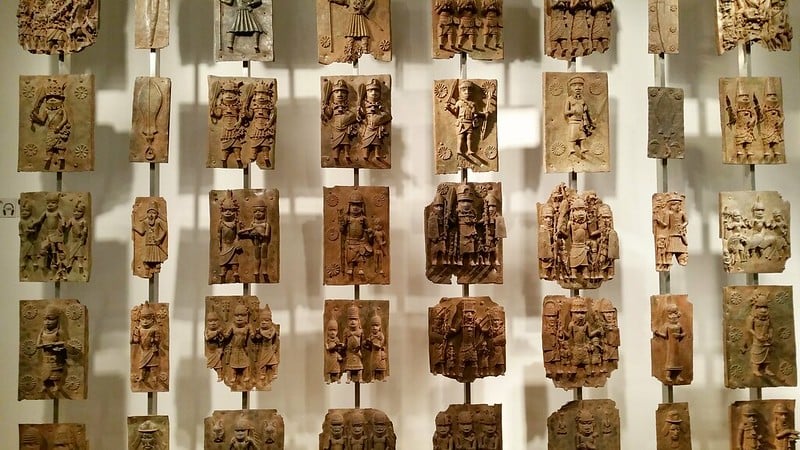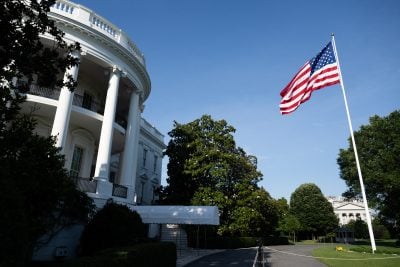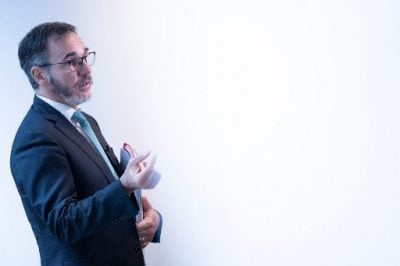Benin City – today one of the biggest cities in Nigeria, located in the country’s southern Edo state – was for hundreds of years the capital of the wealthy and powerful kingdom of Benin. But until recently, tourists hoping for a glimpse into its glorious past were better off booking a flight to Europe than to Africa.
In 1897, the ancient city was destroyed by British soldiers and thousands of historical artefacts – including figurines, tusks, sculptures and an ivory mask – were looted and offered for sale to the highest bidders.
Many of the Benin Bronzes, the name given to the objects, were purchased by European and North American museums, where they stayed for more than a century despite fierce debate about their rightful home.
However, in recent years pressure has been mounting on the holders of these collections to return African artefacts to their places of origin, and the process now appears to have reached a watershed moment.
Museums across Europe and the US have recently announced major repatriation initiatives concerning the Bronzes, frequently brushing aside legal constraints that have prevented state collections from returning looted artefacts in the past.
In June, the Smithsonian in the US undertook to return 29 Benin Bronzes held in its National Museum of African Art collection, in July Germany signed an agreement with Nigeria covering more than 1000 items in its museums and in August the UK’s Horniman Museum announced it would return 72 artefacts.

Restitution gains pace
Now appears to be the time for African countries to push their claims for the return of looted artefacts, as colonial histories are increasingly critiqued and the return of the Bronzes reveals a shift of museum policy.
“Museums across Europe, the UK and the US are now tumbling over each other to announce new policies for returning looted Benin artefacts,” says arts professional Lewis McNaught, founder of Returning Heritage, a not-for-profit dedicated to cultural restitution
Nigeria’s Legacy Restoration Trust has played an important role in the process by providing a politically neutral entity to which the Bronzes can be transferred – both the Nigerian government and the royal family of Benin have unsuccessfully laid claim to them in the past.
This could offer a blueprint for Nigeria and other African countries eager to reclaim both their histories and the accompanying promise of tourism dollars.
“In the past, wrangling over where returning artefacts should be displayed has damaged the pace of African restitution,” says McNaught.
The Legacy Restoration Trust’s plan to house returning Bronzes in the Edo Museum of West African Art in Benin City – designed by Sir David Adjaye and due to open in 2025 – is a “hugely welcome initiative” he says.
A Bronze boost for tourism
“The development of cultural activities such as the building of the Edo Museum can benefit [tourism], especially from increasing domestic tourism spending,” says Fransua Vytautas Razvadauskas, mobility and cities senior consultant at Euromonitor International, a market research provider.
Museums are a significant draw for tourists and the top 100 museums in the world attracted a combined total of 71m visitors during 2021 – despite the Covid-19 pandemic and continued lockdown restrictions, according to The Art Newspaper.
The Musée du Louvre in Paris once again topped the list of most visited museums, drawing 2.8m visitors in 2021 (still well below pre-pandemic levels that saw 9.6m visitors in 2019).
While the full range of economic benefits of the travel and tourism industries are difficult to pin down, Statista projects the French travel and tourism market will reach $16.55bn in 2022.
The travel and tourism industry of Nigeria, which saw significant damage from the Covid-19 pandemic but managed to keep domestic tourism afloat, could use such a boost.
Inbound tourism spending in Nigeria dropped from N455.5 bn ($1bn) to N114.4bn from 2019-20, according to Razvadauskas.
However, domestic tourism spending did not record a substantial fall, only declining from N922.4bn to N898bn, and appears poised for further growth. Euromonitor International forecasts it to exceed N1trillion ($2.4bn) in 2022 and 1.2 trillion by 2025.
“The museum will provide a new magnet for Western tourists keen on travelling to Benin City to learn more about the culture of the Edo people and where the Bronzes came from,” says McNaught. “This can deliver genuine growth in tourist revenues.”

British Museum holds out
McNaught describes the changing attitudes to African artefacts held in Western collections.
“In the past, they have always been considered ‘trophies of war’, objects that belong by right to the victors which should remain on display in Western museums telling the story of colonial histories,” says McNaught.
“But a growing number of museums are pushing these histories aside. More and more now feel that objects acquired illegitimately should be returned to their country of origin.”
Still, in the UK, likely home to the greatest number of Bronzes, it is estimated there are 45 institutions holding looted Benin artefacts.
When London’s Horniman Museum announced the return of 72 Benin artefacts, it joined the ranks of Glasgow City Council, Cambridge’s Museum of Archaeology and Anthropology and Oxford’s Pitt Rivers Museum, who combined have pledged the repatriation to Nigeria of several hundred artefacts.
But one of the outliers is the British Museum, which claims that the British Museum Act of 1963 prohibits it from returning any of the Bronzes in its collection. It has instead pledged to focus on “research and cultural exchange initiatives” in Nigeria.
“The Museum remains petrified that handing back any of its collection of 900 Bronzes will lead to a flood of demands to return other contested items – including the much-disputed Parthenon Marbles,” says McNaught.

The implications of the Benin Bronzes’ homecoming reach far beyond the British Museum and the Bronzes themselves, setting a precedent that could be applied to vast numbers of artefacts in museum collections that have been taken from African countries.
McNaught says that he is already consulting on an Ethiopian restitution project and has another in the works with a significant museum, which “could have major and positive consequences for all African restitution”.
However, McNaught warns that the battle over restitution is not over.
“The Benin Bronzes belong in Benin City, but wider returns to Nigeria would also be significant,” says McNaught.
“Once completed, the new [Edo] museum will provide confidence and reassurance to other Western institutions thinking about repatriating their Bronzes. However, it must remain the focus of attention and resource going forward. Rival plans proposed to create an alternative museum in Benin City to house the Bronzes would be dangerously distracting.”
Want to continue reading? Subscribe today.
You've read all your free articles for this month! Subscribe now to enjoy full access to our content.
Digital Monthly
£8.00 / month
Receive full unlimited access to our articles, opinions, podcasts and more.
Digital Yearly
£70.00 / year
Our best value offer - save £26 and gain access to all of our digital content for an entire year!
 Sign in with Google
Sign in with Google 



